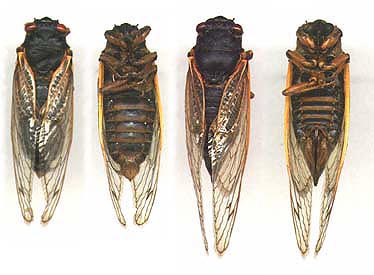New 13-year Pharaoh Cicada

M. neotredecim and its sister species, M. septendecim, are consistently distinguishable only in life cycle length. This species is similar to 13-year M. tredecim, but distinguishable in male song pitch, female song pitch preferences (Marshall and Cooley 2000), abdomen color, and mitochondrial DNA (mtDNA) lineage (Simon et al. 1998, Martin and Simon 1988, 1990). These findings are consistent with the theory that M. neotredecim evolved from populations of M. septendecim by a life cycle change (Martin and Simon 1988, 1990, Marshall and Cooley, 2000, Simon et al. 2000).

The two 13-year -decim species have a special geographic relationship — they are not sympatric (living together) across the entire 13-year range. M. neotredecim inhabits the midwestern part of the 13-year range, while M. tredecim inhabits the southern and southeastern part (see map below). The two species overlap only along a narrow region in northern Arkansas, western Kentucky, and southern Missouri, Illinois, and Indiana. By comparison, the three 17-year species are found together from Connecticut to Kansas, and the remaining 13-year species together inhabit most 13-year populations. Where M. neotredecim and M. tredecim overlap, M. neotredecim songs are much higher-pitched, while M. tredecim songs are slightly lower-pitched. This pattern of reproductive character displacement suggests that the songs have evolved to reduce wasteful sexual interactions between the species.
The photos show that M. neotredecim is extremely similar to 17-year M. septendecim in appearance. The dark bands on the underside of the abdomen are similar to those of M. septendecim. The calling song of M. neotredecim is high-pitched only where it overlaps M. tredecim geographically; the samples below are taken from this overlap zone. Outside of that region, M. neotredecim songs are indistinguishable from those of M. septendecim. The page on Reproductive Character Displacement describes this pattern in more detail.
You can rotate the 3-D models of M. neotredecim below to see them from all angles. These individuals were collected from a population in central Illinois that has atypically light abdominal coloration; more typical M. neotredecim would appear indistinguishable from M. septendecim. This population is found far north of the range of M. tredecim, and the male’s call was found to be 1.3-1.4 kHz, which is typical for undisplaced males of this species.
General information about the signals of this species is included here.
Magicicada neotredecim songs:
The songs below are all high-pitched, displaced songs from the overlap zone.
Courtship I song/ Calling song
Courtship II song
Courtship III song (fragment)
Approximate range
In the map below, cicada symbols are verified records in our database as of 10 March 2025. This map may not be reproduced without written permission.